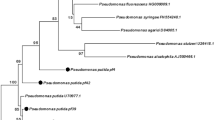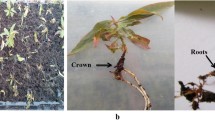Abstract
The stability of rifampicin resistance in plant growth-promoting Pseudomonas putida strain WCS358 was studied in potato rhizosphere in the field. Three out of seven rifampicin-resistant mutants of strain WCS358 were selected in this study. Their specific growth rate, competitive growth in liquid medium and colonization of potato roots in non-sterile soil, was comparable to that of their parental strain. These rifampicin-resistant mutants were used to treat potato seed tubers, which were thereafter sown in the field. To test the stability of the rifampicin resistance in the field, about 1200 fluorescent Pseudomonas isolates obtained from underground plant parts at 82, 95, 109 and 130 days after seeding, were tested for rifampicin resistance and for agglutination with an antiserum specific for strain WCS358. Ail fluorescent Pseudomonas isolates that showed a positive agglutination reaction with the antiserum, were also rifampicin-resistant. Twelve agglutination-positive isolates, selected at random, were all identified as strain WCS358 from patterns of lipopolysaccharides after sodium dodecyl sulphate-polyacrylamide gel electrophoresis. Thus, rifampicin resistance seems to be a stable marker in the mutants of strain WCS358 tested, also under field conditions.
It is concluded that rifampicin resistance can be used as a reliable marker for ecological studies on rhizosphere pseudomonads.
Similar content being viewed by others
References
Andrews J H 1986 How to track a microbe. In Microbiology of the Phyllosphere. Eds. N J Fokkema and J van den Heuvel. pp 14–34. Cambridge University Press, Cambridge, UK.
Bahme J B and Schroth M N 1987 Spatial-temporal colonization patterns of a rhizobacterium on underground organs of potato. Phytopathology 77, 1093–1100.
Bakker P A H M 1989 Siderophore-mediated Plant Growth Promotion and Colonization of Roots by Strains of Pseudomonas spp. Ph.D. thesis. Utrecht University, The Netherlands. 100 p.
Bakker P A H M, Lamers J G, Bakker A W, Marugg J D, Weisbeek P J and Schippers B 1986 The role of siderophores in potato tuber yield increase by Pseudomonas putida in a short rotation of potato. Neth. J. Pl. Pathol. 92, 249–256.
Brockwell J, Schwinghamer E A and Gault R R 1977 Ecological studies of root-nodule bacteria introduced into field environments. V. A critical examination of the stability of antigenic and streptomycin-resistance markers for identification of strains of Rhizobium trifolii. Soil Biol. Biochem. 9, 19–24.
Bull C T, Weller D M and Thomashow L S 1991 Relationship between root colonization and suppression of Gaeumannomyces graminis var. tritici by Pseudomonas fluorescens strain 2–79. Phytopathology 81, 954–959.
Burr T J, Schroth M N and Suslow T V 1978 Increased potato yields by treatment of seed pieces with specific strains of Pseudomonas fluorescens and P. putida. Phytopathology 68, 1377–1383.
Compeau G, Jadoun Al-Achi B, Platsouka E and Levy S B 1988 Survival of rifampicin-resistant mutants of Pseudomonas fluorescens and Pseudomonas putida in soil systems. Appl. Environ. Microbiol. 54, 2432–2438.
Davies K G and Whitbread R 1989 In vitro studies of siderophore production by wild type and rifampicin resistant strains of fluorescent Pseudomonads. Plant and Soil 116, 123–125.
Evans C G T, Herbert D and Tempest D W 1970 The continuous cultivation of microorganisms. 2. Construction of a chemostat. In Methods in Microbiology, Vol. 2. Eds. J R Norris and D W Ribbons. pp 277–327. Academic Press, New York.
Geels F P, Lamers J G, Hoekstra O and Schippers B 1986 Potato plant response to seed tuber bacterization in the field in various rotations. Neth. J. Pl. Pathol. 92, 257–272.
Geels F P and Schippers B 1983 Selection of antagonistic fluorescent Pseudomonas spp. and their root colonization and persistence following treatment of seed potatoes. Phytopathol. Z. 108, 193–206.
Hoekstra O 1981 15 jaar ‘De Schreef’. Resultaten van 15 jaar vruchtwisselingsonderzoek op het bouwplannenproefveld ‘De Schreef’. Publicatie PAGV 11, 1–93.
Hofstad G A J M van der, Marugg J D, Verjans G M C M and Weisbeek P J 1985 Characterization and structure analysis of the siderophore produced by the PGPR Pseudomonas putida strain WCS358. In Iron, Siderophores and Plant Disease. Ed. T R Swinburn. pp 71–75. Plenum Press, New York.
King E O, Ward M K and Raney D E 1954 Two simple media for the demonstration of pyocyanin and fluorescin. J. Lab. Clin. Med. 44, 301–307.
Kloepper J W, Schroth M N and Miller T D 1980 Effects of rhizosphere colonization by plant growth-promoting rhizobacteria on potato plant development and yield. Phytopathology 70, 1078–1082.
Lewis D M, Bromfield E S P and Barran L R 1987 Effect of rifampicin resistance on nodulating competitiveness of Rhizobium meloti. Can. J. Microbiol. 33, 343–345.
Loper J E, Haack C and Schroth M N 1985 Population dynamics of soil pseudomonads in the rhizosphere of potato (Solanum tuberosum L.). Appl. Environ. Microbiol 49, 416–422.
Marugg J D, Spanje Mvan, Hoekstra W P M, Schippers B and Weisbeek P J 1985 Isolation and analysis of genes involved in siderophore biosynthesis in plant-growth-stimulating Pseudomonas putida WCS358. J. Bacteriol. 164, 563–570.
Pankhurst C E 1977 Symbiotic effectiveness of antibiotic-resistant mutants of fast- and slow-growing strains of Rhizobium nodulating lotus species. Can. J. Microbiol. 23, 1026–1033.
Raaijmakers J M, Punte W L M, Bakker P A H M and Schippers B, 1991 A selective medium for reisolation of wild-type Pseudomonas putida WCS358 using its siderophore pseudobactin 358. In Biotic Interactions and Soil-borne Diseases. Eds. A B RBeemster, G JBollen, MGerlagh, M A Ruissen, B Schippers and A Tempel. pp 370–373. Elsevier, Amsterdam, The Netherlands.
Renwick A and Jones D 1985 A comparison of the fluorescent ELISA and antibiotic resistance identification techniques for use in ecological experiments with Rhizobium trifolii. J. Appl. Bacteriol. 58, 199–206.
Schippers B, Bakker A W and Bakker P A H M 1987 Interactions of deleterious and beneficial microorganisms and the effect of cropping practices. Annu. Rev. Phytopathol. 25, 339–358.
Sokal R R and Rohlf F J 1981 Biometry. W H Freeman, San Francisco.
Suslow T V and Schroth M N 1982 Rhizobacteria of sugar beets: Effects of seed application and root colonization on yield. Phytopathology 72, 199–206.
Tsai C M and Frasch C E 1982 A sensitive silver stain for detecting lipopolysaccharides in polyacrylamide gels. Anal. Biochem. 119, 115–119.
Vruggink H and Maas-Geesteranus H P 1975 Serological recognition of Erwinia carotovora var. atroseptica, the causal organism of potato blackleg. Potato Res. 18, 546–555.
de Weger L A, van Boxtel R, van der Burg B, Gruters R A, Geels F P, Schippers B and Lugtenberg B 1986 Siderophores and outer membrane proteins of antagonistic, plant growth-stimulating, root colonizing Pseudomonas spp. J. Bacteriol. 165, 585–594.
de Weger L A, van der Vlugt C I M, Wijfjes A H M, Bakker P A H M, Schippers B and Lugtenberg B 1987. Flagella of a plant-growth-stimulating Pseudomonas fluorescens strain are required for colonization of potato roots. J. Bacteriol. 169, 2769–2773.
Weller D M 1984 Distribution of a take-all suppressive strain of Pseudomonas fluorescens on seminal roots of winter wheat. Appl. Environ. Microbiol. 48, 897–899.
Author information
Authors and Affiliations
Rights and permissions
About this article
Cite this article
Glandorf, D.C.M., Brand, I., Bakker, P.A.H.M. et al. Stability of rifampicin resistance as a marker for root colonization studies of Pseudomonas putida in the field. Plant Soil 147, 135–142 (1992). https://doi.org/10.1007/BF00009379
Received:
Issue Date:
DOI: https://doi.org/10.1007/BF00009379




